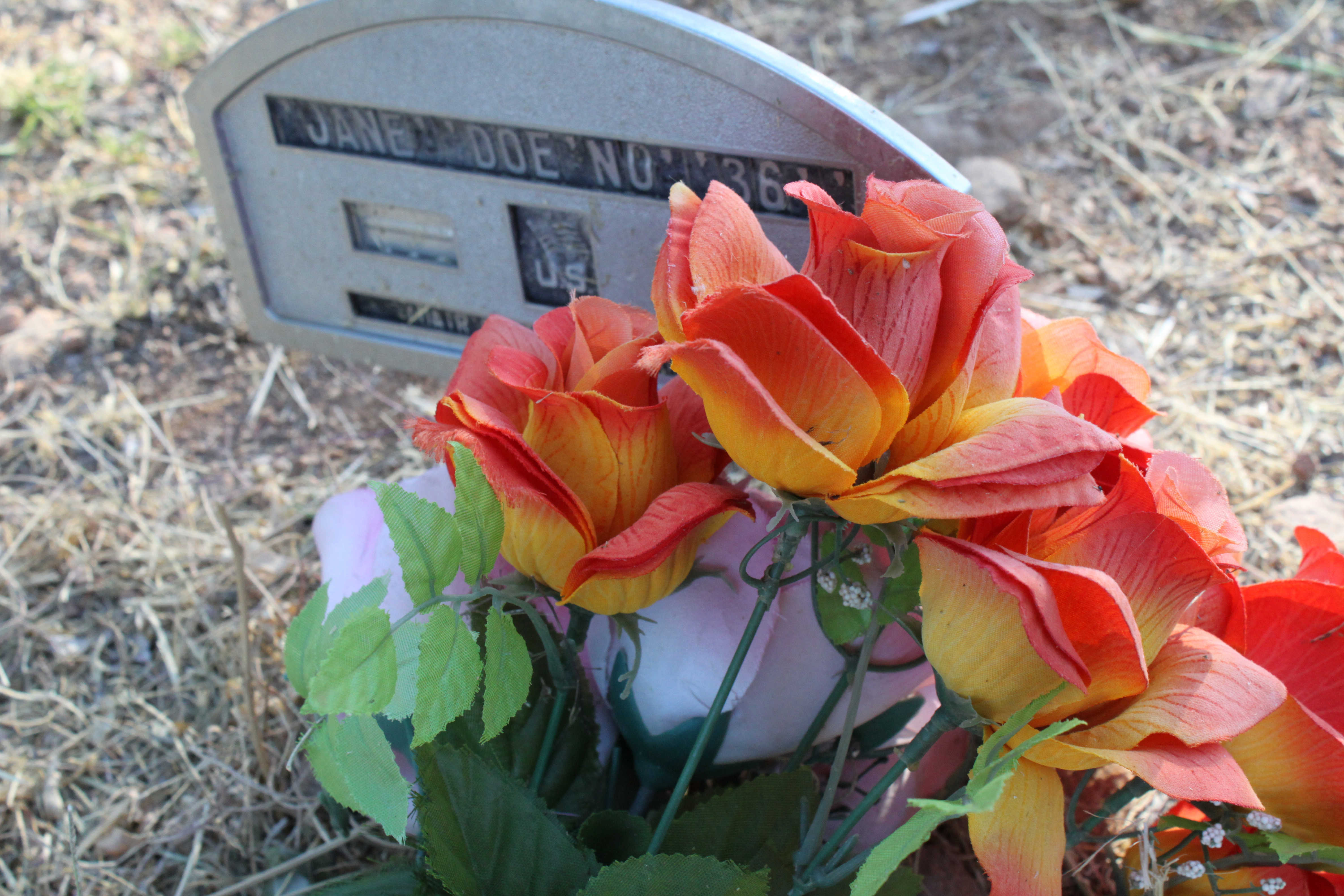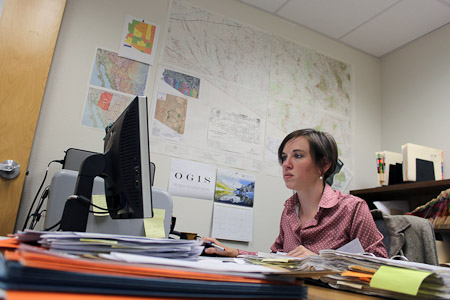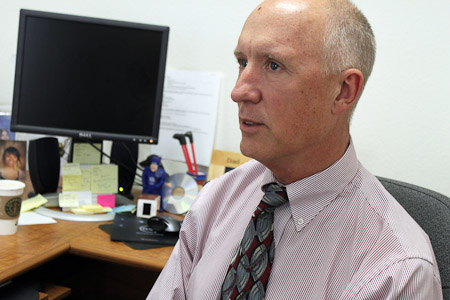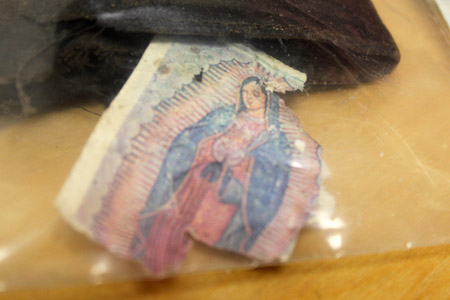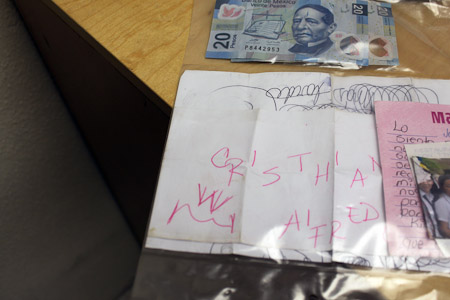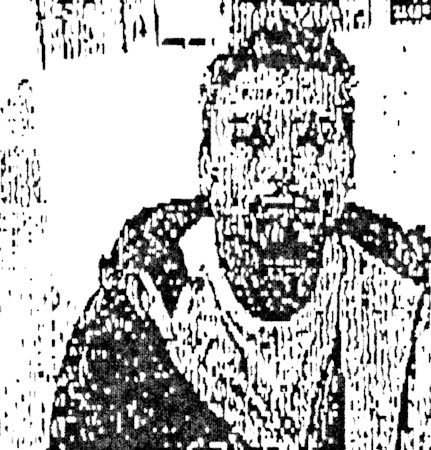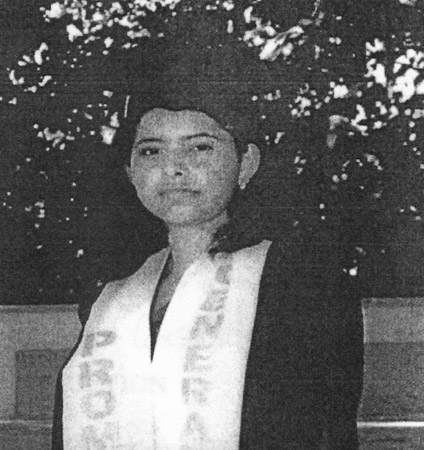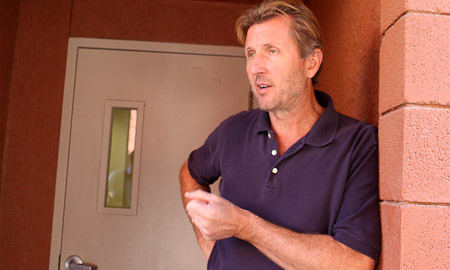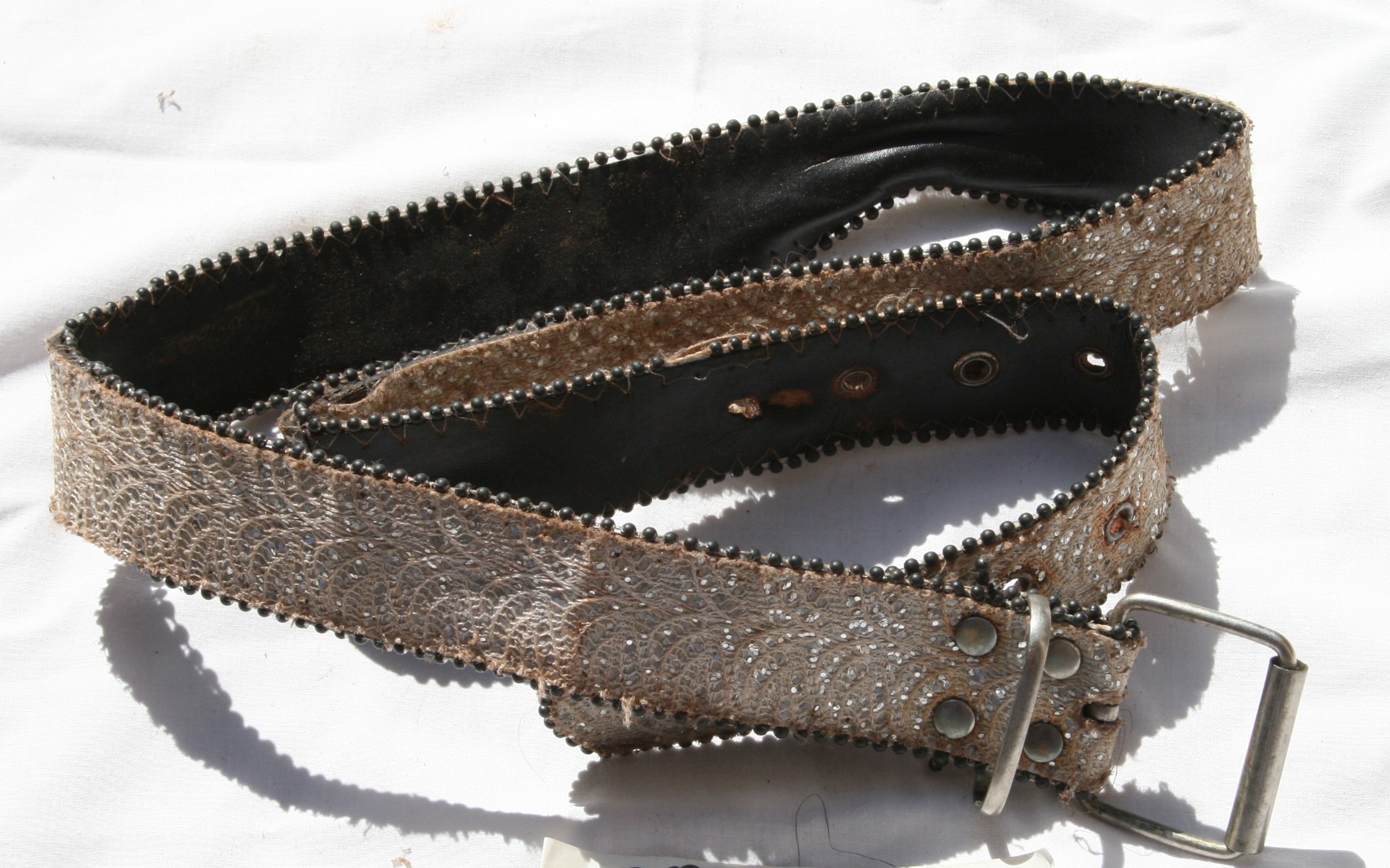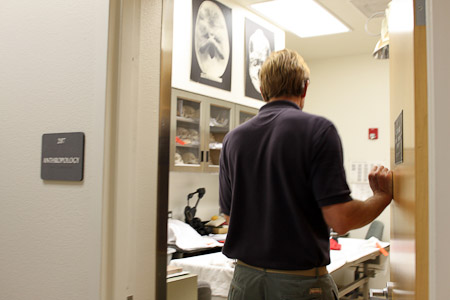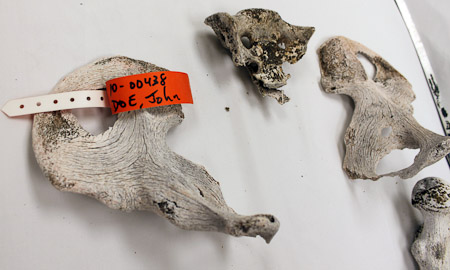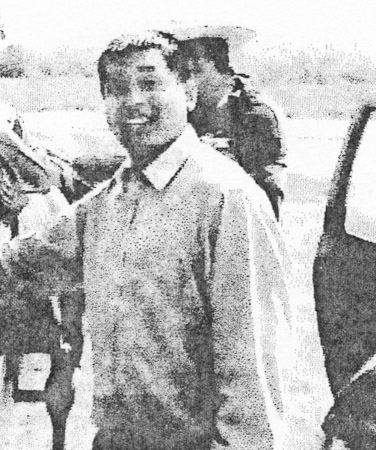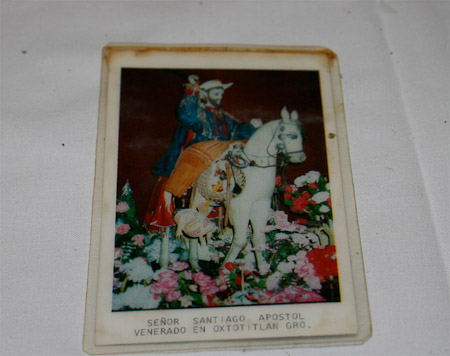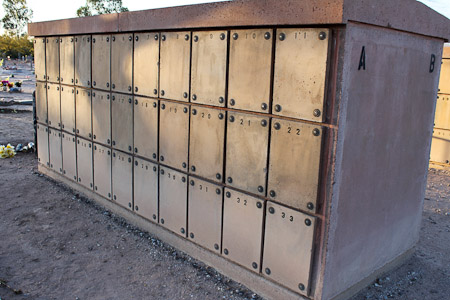Unidentified dead common on the border
(also available at the News21 2010 ASU Team site and in pdf)
TUCSON, Ariz. -- The calls come in every day from people who are searching for sons and fathers, mothers and daughters, sisters and brothers. Robin Reineke seems unfazed by the volume as she patiently asks the same questions case after case.
Where was he going? When was she last seen? How tall? How much does he weigh? Does she have any tattoos or scars? Has he had any dental work, and do you have a picture where he’s smiling?
Reineke, a University of Arizona graduate student, is working for the Pima County, Arizona Medical Examiner's Office, trying to identify the unidentified -- scores of people who have died in the desert, most of them migrants crossing illegally from Mexico to the U.S.
Pima County is more successful than most at the task -- it identifies 70 percent of the bodies brought in. Yet staff members push themselves to do better -- they know that for the 30 percent of their cases that are unresolved they cannot return the body to family members. And those mothers, fathers, sons, daughters, husbands and wives may never be at peace.
“The tragedy of the situation is similar to the tragedy that we see on a daily basis here of people who often through no fault of their own or maybe were naive to some degree end up dying at the wrong place at the wrong time,” said Dr. Bruce Parks, Pima County’s medical examiner.
Since 2001, Parks’ office has handled more than 1,500 border-crosser deaths, a major increase from prior decades. More than 500 are John or Jane Does -- people whose bodies have been too damaged by the harsh desert conditions or who carry no verifiable identification.
Southern Arizona became a preferred place to cross in the 1990s, when U.S. immigration officials implemented tougher border enforcement through Operation Gatekeeper in California and Operation Hold the Line in Texas. The clamp down in those states funneled more illegal immigrant traffic into Arizona. In the meantime, border security has been increased across the board, with more formidable fences and an increase in Border Patrol officers. All this has resulted in smugglers leading migrants through more remote territory -- higher into the mountains, farther from towns and highways and deeper into the desert.
“It’s been going on now for over 10 years and there are offices like this which are involved in finding out who the people are and there're offices doing other aspects of the work to try to locate these people and save them and take care of them and render medical care, if they're lucky enough to survive,” said Parks. “So in southern Arizona, and a few other places along the border, it's a big deal and it's a sad situation.”
And the problem continues to grow worse. So far 2010 has broken records for migrant deaths each month: 18 deaths in January; 24 in February; 11 in March; 14 in April; 17 in May; and 25 in June.
The process of identifying the dead is a painstaking one. Sometimes things fall into place -- a missing person’s report matches physical descriptions of a body or other descriptions provided by relatives searching for loved ones.
Reineke is the last person relatives of missing persons call. It means they’ve already spoken to other family members and aid workers searching for loved ones; they’ve already checked with the detention centers and the consulate offices. They’re facing an unpleasant possibility -- that their search will have a quick ending and a very permanent resolution. The reality is that, for many of them, a process with an uncertain ending has only just begun.
After each phone call, Reineke hangs up, and the detailed work of cross-checking the missing persons report with possible matches in the medical examiner’s records begins.
As she goes through clothing and effects, she’s looking for anything that stands out as unusual, something that might make the person identifiable to relatives searching for missing loved ones. For one John Doe, it was a religious token.
“I always enter all of the clothing this person was wearing, and I try to enter as much detail as I can about any words on personal documents," Reineke said. "One of the documents that was found with this body was this saint card.”
Many migrants carry scapulars, saint cards that they pray will give them extra protection on the dangerous journey north. When Reineke began cataloging effects for the body recovered July 7, 2008, the saint card stood out not because it was there but because it wasn’t the Virgin of Guadalupe or another familiar saint. Instead, Señor Santiago Apostol, venerated in the town of Oxtotitlan , state of Guerrero, in southwestern Mexico, was someone she had never heard of.
“But the important thing was that on the back, there’s this handwriting here,” Reinke said.
Some words were clear -- “Victorino,” “Grande” and possibly “Cruz” -- while others, like what might be “Acattandela,” were puzzling.
“I wrote that in the notes,” Reineke said. “And then I actually had a couple of dreams about that word I think ‘cause it stuck in my head and I was Googling it a lot because I was trying to figure out if it was a town or a village or someone's last name and I kept coming up with nothing. These two t's, that's really unusual in Spanish, so I couldn't figure it out.”
Also noted in the John Doe’s case file -- a rosary, a blue shirt, black pants, red and black shoes. Reineke looked at the information, entered it and searched among the missing based on time, location, and physical descriptions -- but among nearly 500 unique, complicated cases, there was no instant match.
A match was finally made – seven months later.
Each time an unidentified body is found, a new story starts for Reineke. Each missing person report becomes a file with a case number assigned to the name, the story and the family’s contact information. Carmen Antunez Grande, Estefany Lisseth Chavez Chavez and Luis Yair Zamudio Rodriguez are among the Pima County cases.
Luis Yair Zamudio Rodriguez, 31, was from the state of Oaxaca, Mexico but had lived in Phoenix for over 20 years. When his attorney called Reineke to file a missing person report, Luis had last been seen Aug. 19, 2008.
Estefany Lisseth Chavez Chavez was also trying to reach family. The 17-year-old from El Salvador hadn’t seen her parents since they left her with relatives to try to make a living in Southern California. Of the cases reviewed for this story, she is the only person who had never lived in the United States. According to her missing person report, she was last seen May 16, 2008.
Carmen Antunez Grande was going to rejoin his brothers, partner and child in North Carolina after visiting Mexico to take care of family there.
LUIS
Luis Yair Zamudio Rodriguez, 31, had lived in Phoenix for more than a decade. He was married with three children who were all U.S. citizens. But his missing person report was filed by his attorney in Florence, Ariz., because after a year of struggling for legal residency, Luis had exhausted all options but voluntary departure. So he left but decided to return.
“He tried to re-cross to join his wife and three children in Phoenix, but he was never seen again after Aug. 19,” Reineke said. “All his family knows is that he was crossing with one other man who had been deported. This man said that Luis' feet had become damaged and he couldn't continue.” The man traveling with Luis remembered part of the name of the place where he had left Luis -- at “Marshall Station,” “Mars Station” or maybe “Marsh Station.”
There had been no new word for two weeks. At the same time, Luis’ wife and children were facing eviction in Phoenix, because without him working, rent was unaffordable.
When they filed a missing person report on Sept. 12, 2008, Luis’s family thought they knew where he had been left and heard that a body had been recovered from the area. The family attorney faxed a missing person’s report with his name, photograph and fingerprints to Reineke.
Along with a pair of Nike tennis shoes and a receipt from a Mexican drugstore dated Aug. 16, three days before Luis was last seen, the body recovered on Aug. 31 near Marsh Station road and Interstate 10 had legal documents with Luis’ name and a Phoenix address.
Luis’ autopsy report lists the cause of death as hyperthermia -- overheating of the body. His wife’s examination of his teeth finalized the identification. She was now officially a widow with three young children.
Reineke said the deaths and disappearances she deals has the biggest impact on citizen children of immigrants, who are often left without one or both parents, sometimes far from other family members. “They're probably being more affected then their relatives in Mexico, for instance,” she said. Most unidentified cases handled by the Pima County Medical Examiner's Office do not move so quickly.
Luis’ travel companion was willing to talk and gave important, accurate information about when and where Luis was last seen. The family and Luis’ attorney acted quickly, contacting the Mexican Consulate and the medical examiner; Luis himself was carrying identifying paperwork that helped make the circumstantial identification. That led straight to a positive identification based on his medical and dental records.
Without documents, with a bigger gap in time, or with less information known, a case quickly becomes much more complicated.
ESTEFANY
The call came in to law enforcement shortly after 6 p.m. on May 26, 2008, from a mile marker on Arizona state route 286. A local man walking his dog spotted buzzards in the sky. He investigated, thinking one of his cattle had died. Instead, he found a young woman face down, a shoe nearby.
The Border Patrol arrived, secured the area and took his statement. A deputy and then a forensics officer arrived from the Pima County Sheriff’s Department. They photographed the scene. The deputy helped place the body into a bag and then into the Medical Examiner's vehicle that would take her to Tucson. She was another Jane Doe.
The Mexican Consulate was notified and came to examine the body as well, looking, like Reineke, for clues that would lead them to her name and family: her glittery belt, her crooked front teeth -- a condition known as maxillary winging -- her young age and tiny stature.
About the same time, the family of Estefany Lisseth Chavez Chavez was contacting the El Salvadoran Consulate, worried about their daughter. Estefany was 17 on May 16, 2008, when she last communicated with her father from Puebla, Mexico. This was not the start of her journey, but the middle. She had already traveled a long way since she left her home with relatives in El Salvador on May 8. She was coming to join her parents, who’d been living in Southern California for years now, saving enough money first to send back to her and then to bring her to them.
Reineke said Estefany went set out to cross the border into Arizona on May 20. Many people in the group she had traveled with ended up in detention -- but Estefany did not. “She wasn't detained and they don't know what happened to her.”
The Salvadoran consulate put together a flier with Estefany’s name, information and the dates. At the top, her photograph shows her alone, in graduation regalia from her school in El Salvador and with serious expression on her face.
Reineke began her search after she got the report from the Salvadoran consulate. And she called the family to ask follow up questions, including whether Estafany had crooked front teeth -- like the body that was found on May 26.
“I talked to the dad in California, and this was on a Friday, and he showed up here on a Monday,” Reineke remembers. “He drove all the way with three of his other family members, to come here. And they were waiting in my office when I showed up here on Monday morning.”
That office is a testament to the ongoing identification process. One set of shelves holds the case files of the unidentified, two others hold the case files of the missing. A corner desk is available for staffers of the federal database known as the National Missing and Unidentified Persons System, or NAMUS, described on its website as “a clearinghouse for missing persons and unidentified decedent records.”
Two walls are covered with maps -- the state of Arizona, the cities along the border. One of the maps includes the GIS readings of water stations, Border Patrol rescue beacons and death locations. It was put together by the Tucson-based humanitarian group Humane Borders.
Another wall has a few photographs of memorable effects -- a handwritten note, a sneaker with a name inked into the stripes, a penciled sketch of a horse. Press releases, missing posters, a list of aliases and a full map of the United States. Also, the story of Josseline Hernandez Quinteros -- a 14-year-old El Salvadoran girl who died in the desert.
Reineke’s desk is perpetually covered in the paperwork of the moment.
The conference room around the corner is larger, yet still private, with bookshelves and a Southwestern décor. Here, Reineke and Dr. Bruce Anderson who has been with the office for more than decade, went through descriptions of Estefany’s possible routes and her clothing when last seen -- blue sweater, blue jeans, black tennis shoes with red decorations, a hair tie. They discussed Estefany’s stature -- a little over 5 feet and maybe 125 pounds -- and her teeth: all natural, no dental work.
They compared everything to the Jane Doe in the lab. Because of the condition of the body, the evidence discussed in the conference room would be important, if not conclusive, in narrowing down who the Jane Doe might really be.
“You can't count on it obviously because sometimes people change clothing,” Reineke. “And there's always the possibility that even if they didn't change clothing that someone changed their clothing for them, it's just a … possibility that you have to entertain.”
Finally, the aunt and uncle went to look. Afterward, they were sure the body was Estafany.
“They really believed that it was her, based on the crooked central incisors,” Reineke said.
The circumstantial identification was noted in the file: ML 08-0996. A DNA sample was prepared for processing by BODE Technology, a Virginia DNA identification lab that works with law enforcement nationwide.
Reineke said family and friends pooled their money to pay for the DNA exam, which cost around $600. Everything hinged on the results. The DNA was not a match. The body was not Estefany's.
“And it turned out not to be her, which is sadder like three times over because that means that there's another 17-year-old or 16-year-old dead girl that's not Estefany, and the family went through all of this and they didn't find their daughter, so… we're still looking for her," Reineke said.
A case photo of the glittery belt hangs on the computer screen. It poses the same challenge, more forlornly, as Estefany’s graduation photograph.
“So that’s Estefany, and the girl that turned out not to be Estefany.”
JOHN DOE
“He was found on the 25th of February,” Dr. Bruce Anderson said, standing over a table in his pathology lab, looking at fragments of what used to be a complete body -- a cranium, shoulder blade, pelvis, left leg bones, and teeth. When little else is found with a body, the identification process focuses on the bones.
According to Anderson, there should be about 200 bones in a complete human skeleton. But if the body was undiscovered for 2 to 5 years like this one, there had been "a lot of time for animals and critters to haul stuff away -- we've had time for people to take portions away if they wanted to,” Anderson said.
The more complete a skeleton is, the more accurate Anderson can be with gender, age, height and weight -- the markers that begin to recreate the missing person and create a profile for comparison against the missing. Anderson said the best indicator of sex is the pelvic bone -- women have a birth canal that men do not. Also, adult female skeletons are basically larger versions of the same bones the woman had as a child. Males on the other change over time -- they "look rougher" in the face and forehead after puberty.
For the pieces on the table, a determination is cumulative.
“So the combination of a big body, big muscles, rough skull and a male-looking pelvis, argues very strongly that this is not a woman,” Anderson said. “Here, there's little doubt in my mind this is a man, it'd be the first woman that combined all these features that I've ever seen in my career, so, I'd be very surprised if this turns out to be a woman.”
This John Doe has been given the case number ML 10-00438 -- the 24th unidentified body found in February 2010, the 29th of the year.
“The bones and then these shoes were delivered, so my assumption is that the police think these shoes are related to the bones,” Anderson said.
But it’s hard to be sure. In fact, nothing about this case will be easy. The trail is cold from the beginning.
“This guy's been dead for several years, I don't think he died last summer, so we're probably looking at '07, '06, maybe even longer than that.” Anderson goes through the case step by step, recording every observation.
“Bone is about yellow,” Anderson said. “It turns white because of solar radiation, so this is what we call sun bleaching. That almost never happens before about a year of direct exposure, daily exposure to the sun."
Bone by bone, he looks for clues that can narrow the possibilities on when the man died.
“The cracking usually doesn't start till about a year, this checking on the surface doesn't occur till after a year. This pinkish hue sometimes takes several years to form.”
Once again, unique factors stand out -- rare age or height marks left on a bone broken in childhood, unusual dental work.
Anderson points out that teeth can dramatically narrow the possibilities for a match with a missing person. Dental work or missing teeth means that Reineke can sometimes narrow down the possible matches to a list a few hundred people. But if the dead person has all of his or her teeth? "What can we do with that?" Anderson asks rhetorically. "You can't do anything with that, it's too big of a number.”
These are the cases where databases will make the most difference.
“In a perfect world if we had blood or saliva samples from the families of all 420 men or whatever that was, we could then sample this for DNA and run that against there and hope and hope that one of those families actually were the family of this guy,” Anderson said.
Databases like NAMUS allow families to look for cases similar to those of the relatives they’re searching for and then contact the office that posted the information. In too many cases, the searches last for years.
“I've talked to enough mothers and fathers of missing people who, that consumes them, and that they go home and night and they can't do something constructive -- they feel like they're not doing enough to find their child,” said Anderson. “So with NAMUS, every time you want to go online and you search the case that came in today… it's a terrible thought, but the case that came in today could be the child you've been missing for 20 years … If we could get the families of every missing person, which is never going to happen, but if you could get all those families looking at NAMUS, there'd be hundreds or thousands of ids rather quickly. Because the families would see something amongst the descriptions of the dead.”
A name association can be a case’s break through point.
“The family now is in a position to either tell us something about him that we can evaluate him by and say, 'Yeah, we believe that's him, or give us a blood or saliva sample and we'll try to analyze using that,'” Anderson said.
For this John Doe, it may be a deciding factor, since today’s technology makes it possible for any bone in a human body to potentially provide testable DNA.
“[E]very time we identify someone I get the anthropology report out and we grade ourselves -- how did we do -- did we get the age right, did we get the sex right, hopefully we got the sex right,” Anderson said.
They’ll verify the nationality, too, as the office’s unidentified cases are not limited to migrants or border crossers.
“I say we probably have over-counted,” Anderson said. “If we were lucky enough to have all of these people identified eventually, I'll be very surprised if not one or more or several are actually missing Americans.”
Who is John Doe, case ML 10-00438; a missing American or a border crosser?
“Until he's identified, we'll never know,” Anderson said.
CARMEN
Carmen Antunez Grande had made the trip before. Not only were seven older brothers in North Carolina – a wife and, soon, a baby waited for his return.
His family reported Carmen missing in July to Kat Rodriguez at the humanitarian organization Derechos Humanos. They provided Rodriguez, and later Reineke directly, with information, photographs, and ultimately X-rays in the hopes of tracing him.
The family said he had large birthmarks on his face and black hair, and on his right knee he had a scar from an operation. He had been wearing a dark blue long-sleeve shirt with black dress pants.
“What caught my eye was I was entering Carmen's information into the database and I noticed this red shoes, blue shirt and black pants combination, and I remembered there being some combination that was really similar,” Reineke said. She started going through the cases again -- until she got to one John Doe, case ML 08-01295. “And I was like, wow, well, that's exactly what they said -- dark blue long sleeve-shirt, black dress pants, this is what the family reported, black tennis shoes with red stripes.”
The age range and stature were close -- 28 to 45, 68 inches, more than 145 pounds. Carmen was 26, tall and around 170. It was close enough. “I decided to call the brother and ask him if he would view these photographs of the clothing, and if they would be familiar to him,” Reineke said. “And I asked him while I was on the phone with him, you know, do these names, Victorino, Attendela ring a bell?”
They didn’t, so Reineke sent photographs of the shirt, the shoes, the rosary, the front and back of the saint card.
“He called back and he said ‘First of all, I'm certain that this is my brother and I know because this card, this is our saint that we venerate in our town,'" Reineke remembers. The brother deciphered the rest of the writing on the card: "Acatlan de la Cruz," the name of the family's home town in Guerrero. And "Grande," part of Carmen's full name: Carmen Antunez Grande.
Carmen’s family sent photographs, and then skeletal radiographs taken after knee surgery.
“It actually wasn't the injury or the surgery that identified him, it was the morphology of the bone,” Reineke said. “So we were able to take the ante-mortem -- prior to death -- X-rays and compare them to post-mortem X-rays and just look at the shape, the contour of the patella, and compare those between ante-mortem and post-mortem to say it's the same individual.”
In Carmen’s case, that resulted in a positive id. But process wasn’t over.
“Once you get to the positive ID point for the scientist, it's not necessarily easy from then on out, for a number of reasons,” Reineke said. “A lot of times … it's not good enough for the family, why should they trust you. Your belief in those methodologies, you might have those for specific reasons that you've been educated to believe and you understand statistics and why it's more likely to be him than anyone else, but when a family can't look someone in the face, it's very hard for them to take a set of bones and trust you that this is their brother.”
For Carmen’s family, the handwriting helped with absorbing the technical and medical conclusions.
“For them, it was just really challenging because, and I remember him calling -- this is one family I gave them my cell phone number because they were really nice and really upset and I wanted to be able to respond to them if they needed something.” But officially, Reineke’s role -- and the role of the medical examiner’s office as a whole -- ends once one of its doctors signs off on paperwork that releases the body to the family, consulate or funeral home.
Carmen’s family waited more than six months for an answer that might never have come.
“I felt really bad because they reported the person, they reported Carmen missing on the 16th of July … and the body was found … on the 7th of July,” Reneike said. “It was in the winter by the time I figured it out.”
The delay bothers her.
“He was one of eight brothers and they all had migrated, and he was the very last one, he was the youngest, and he basically was staying there to help out with his parents, and he was very connected to his family,” Reineke remembered. “He fell in love with someone and got married.”
When Carmen’s was identification was finished, there was one more person waiting for the news.
“By the time we ID'd him he had a 3 or 4 month little baby son.”
THE UNIDENTIFIED
Each closed case is a step – but the staircase keeps growing.
The staff members of the Pima County Medical Examiner's Office are realistic about the challenges they face, as well as the solutions they’re working to implement.
“The identification process is always part of our biggest challenge,” Parks said. “And storage space -- we end up holding on to people for a long time to get all the work done that we need to do.”
Also at issue are time and money. Grant funding is being sought for additional forensic consultants to work under Dr. Anderson, and for database building. Currently, a sample is collected from each unidentified person so that if relatives come forward now or in several years, a DNA test will be possible. Databasing these samples and samples from families may produce matches that were missed before. So might the geospatial database that Reineke is building that will prioritize her record cross-checks and hopefully save valuable time for both families and staff, leading to even more matches – and more returns.
“It's going to save hours and hours of time,” Reineke said. “Ideally, if they call up today, Friday, maybe on Monday I can come up and the system will have processed several possibilities, and at least I can say, ok, we have a possibility -- two of them have tattoos, one of them has this characteristic, do you know, you know, could this, did your brother ever have some particular dental thing, or did they ever have surgery, or did they speak with a lisp, or did they have a painful tooth -- you can try to narrow it down and rule people out that way.”
Reineke believes the database will also mean more matches. Cases like Carmen’s “made me wonder how many cases are like that that I'm overlooking or that we're overlooking.”
This meticulous cross-checking is how Carmen and Luis were both returned to their families. Parents, siblings, spouses and friends made decisions about their funerals and burials.
For John Does and Jane Does, there comes a time when that decision is made by medical staff and county officials to bury or cremate them. In Pima County, the medical examiner releases bodies to the county’s public fiduciary that makes the arrangements for a burial or, as Arizona state law allows, the more affordable option of cremation.
The county cemetery sits within a corner of Evergreen Mortuary, Cemetery and Crematory next to a busy intersection. The county has a contract, regularly put up for bid with local mortuaries, to handle unidentified cases.
The later burial plots in the county section hold two bodies per grave said William B. Addison, Evergreen’s president who worked there since 1965. Addison said that, though it has the option, the county does not usually cremate remains.
“The problem with cremation is that you can't undo it. You bury somebody, no problem -- you really want to be cremated, we can handle that -- disinter them, cremate them, and there you go. But if you've cremated somebody first, you can't un-cremate them, haven't quite figured out a way to put all that together yet, so they're still sensitive to the possible issues and will usually hold off on cremation unless they have some reason to believe that wouldn't be a problem.”
The sensitivity lies in the question of identity. Personal or religious wishes are just as indecipherable as name and nationality.
It is here, at the very end, that the impact of being identified or unidentified – between closed case and open case, found and not found, between knowing and not knowing, becomes most immediate and final.
“The sooner, obviously, the sooner they find out, the better off they are, no matter what the news is,” Addison said. “No news is good news is not necessarily true if they're expecting the worst in the first place.”
